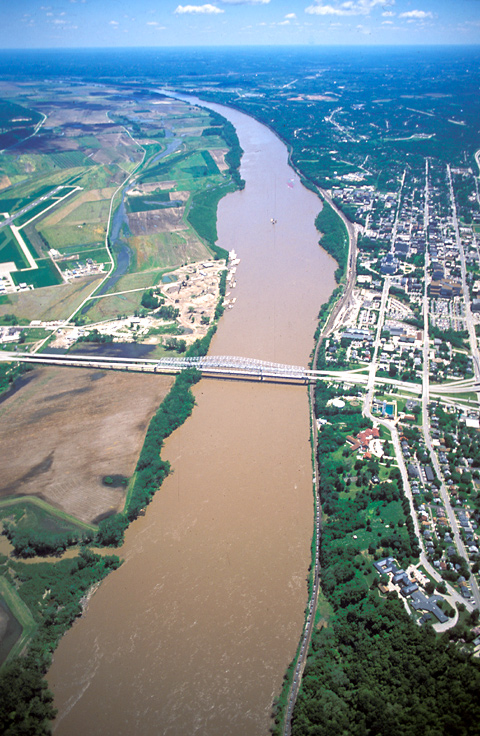On Sunday, 3 June 1804, the expedition left its camp at the mouth of the Osage River and proceeded five miles upstream to the mouth of the Moreau River (in the photo, near and parallel to the top, around the curve, going off to the right). There, Clark wrote, he and his men, and especially their primary interpreter, scout and tracker, George Drouillard, “Saw much sign of war parties of Inds. having Crossed from the mouth of this Creek.”
That night was especially memorable, for the next day Clark named a small creek a mile upstream from their camp Nightingale Creek, “from a Bird of that discription which Sang for us all last night, and is the first of the kind I ever heard.” The nightingale is not a North American bird, and the journalists left no other clues as to what species was heard, although the most likely candidate seems to be the Chuck-Will’s Widow, Caprimulgus carolinsis.[1]See Clark’s ‘Nightingale’.
That afternoon, several miles upstream, Sergeant Ordway, at the helm of the keelboat, snagged the rigging on an overhanging tree and broke the mast. The heavily-laden, lumbering craft was fifty-five feet long, with an eight-foot, four-inch beam and a three-foot draft. With most of its weight above the waterline, it must have been difficult to handle in the Missouri’s brisk, meandering, unpredictable current. Clark commemorated the accident by naming a nearby stream Mast Creek, where they may have cut lumber to mend the break.
On the return trip in 1806, riding a current that tumbled along at nearly seven miles an hour, the Corps raced past Nightingale Creek and the Moreau River. “The men ply their oares,” wrote Clark, “& we decended with great velocity.”
On the 19 September 1806, four days from St. Louis, they were entirely out of provisions, yet they paused only long enough to pick some sweet, creamy pawpaws (possibly Asminia triloba, often called “prairie bananas”), which were ripening then. Some authorities speculate it was an irritant in the fruit’s rind that caused the temporary eye problems that left three men unable to help row. The plus side of that situation was that it prompted the captains to abandon the two smallest, and by now superfluous, canoes.
Congress designated Missouri as a Territory in 1812, named St. Louis as its capital, and appointed William Clark its governor. Within less than ten more years Missouri Territory attracted enough new citizens to qualify for admittance as the twenty-first state in the Union, and in 1826 the state legislature met in the new capital, the City of Jefferson. The first railroad, which truly opened the west, Lewis and Clark’s achievement notwithstanding, reached Jefferson City in 1855 and at last, upon its completion in 1862, linked the two oceans. The track on the southwest side of the river belongs to the “MoPac.” Immediately downstream from the two bridges is Jefferson City Sand and Gravel Company, which dredges its commodity from the river’s bottom to keep the channel open for commercial barge tows. Between the river and the airport, a road rides atop a dike that protects the airport from periodic flooding. The clear water to the right of the dike is the channel that once separated Clark’s big “Cedar Island” from the northeast riverbank.
From Discovering Lewis & Clark from the Air
Photography by Jim Wark
Text by Joseph Mussulman
Reproduced by permission of Mountain Press
Notes
| ↑1 | See Clark’s ‘Nightingale’. |
|---|
Experience the Lewis and Clark Trail
The Lewis and Clark Trail Experience—our sister site at lewisandclark.travel—connects the world to people and places on the Lewis and Clark Trail.
Discover More
- The Lewis and Clark Expedition: Day by Day by Gary E. Moulton (University of Nebraska Press, 2018). The story in prose, 14 May 1804–23 September 1806.
- The Lewis and Clark Journals: An American Epic of Discovery (abridged) by Gary E. Moulton (University of Nebraska Press, 2003). Selected journal excerpts, 14 May 1804–23 September 1806.
- The Lewis and Clark Journals. by Gary E. Moulton (University of Nebraska Press, 1983–2001). The complete story in 13 volumes.


